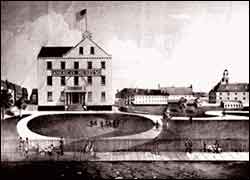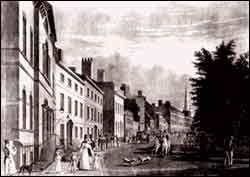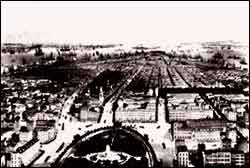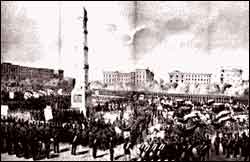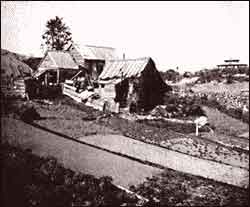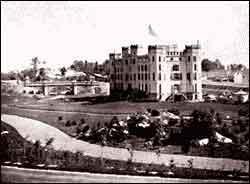Parks for the New Metropolis (1811–1870)
1811
"It may be a matter of surprise," admitted the commissioners in remarks accompanying their 1811 plan for the city, "that so few vacant spaces have been left...for the benefit of fresh air." The meager 470 acres of open area they designated for all of Manhattan were intended to serve as small squares, parade grounds, markets, and sites for reservoirs. Even these limited restrictions on development were subsequently ignored. Union Place, formed at the union of Bloomingdale Road (Broadway) and the Bowery, extended from 10th to 17th Streets in the 1811 plan. It was reduced to its present size when it was landscaped and renamed Union Square in 1832. Out of a planned 55-acre "Market Place" between First Avenue and the East River, only 10.5-acre Tompkins Square Park, laid out in 1833, was left as open space. A 44-square block "Parade" proposed between 23rd and 34th Streets was reduced to 6.25 acres when Madison Square Park was officially opened in 1847. As New York grew in the 19th century into the great metropolis of North America, it did so with almost no parks.
1818
The Rotunda, New York's first art gallery, was erected in 1818 in City Hall Park northeast of City Hall, establishing a tradition of museums in parks. After serving a number of uses, the Rotunda was demolished in 1870.
1834
The Village of Brooklyn was incorporated as a city, which gave it increased powers to lay out squares and parks. By 1839, a board of commissioners had presented a city plan with 11 planned parks and squares including Washington (Fort Greene) and Tompkins (Von King) Parks.
1836
The oldest park on Staten Island, Veterans Park in Port Richmond, was laid out in 1836 as Port Richmond Park. It was renamed after World War II.
1840
The Green-Wood Cemetery opened in Brooklyn in 1840. The private cemetery had 478 landscaped acres and 20 miles of pedestrian paths open to the public. Green-Wood introduced the public to the amenities of the landscaped "pleasure ground." Many New Yorkers felt that only the creation of a large pleasure ground park in New York would remedy the cramped conditions of the metropolis.
1841
An 1841 map of the town of Flushing shows the site of Daniel Carter Beard Memorial Square (known as Flushing Park until 1942) as a public park, which may make the square the oldest park in Queens. Another early Queens park is Wyanda Park, acquired by the town of Jamaica in 1844.
1845
The rules of baseball were officially set down by Alexander J. Cartwright, a 25-year-old volunteer fireman, and the game as it is now known was first played in the vicinity of Madison Square. Madison Square Park was officially opened in 1847 after the demolition of the state arsenal (constructed there in 1806) was completed.
1847
Besides Madison Square Park, two other parks opened in 1847, Reservoir Square (Bryant Park) became a public park that year, and in 1884 it was renamed after William Cullen Bryant, the editor of the New York Evening Post who crusaded through the 1840s for the creation of Central Park. In Brooklyn, Washington Park (Fort Greene Park) was established in 1847, successfully concluding a long struggle led by Walt Whitman, editor of the Brooklyn Eagle, for more parks in Brooklyn.
1848
The state constructed an arsenal near 64th Street and Fifth Avenue to replace the recently demolished Madison Square arsenal. The Arsenal, as it is now known, was designed by Martin E. Thompson and is one of the two extant structures in Central Park older than the park itself. The other is the Blockhouse, built in 1814.
1850 Eighteen-fifty was a watershed year for the park movement in New York. For years concerned citizens like William Cullen Bryant had argued for the creation of a large central park to alleviate crowded conditions in a city that had grown from about 97,000 in 1811, to a metropolis of well over 500,000 in 1850. Andrew Jackson Downing, landscape designer and author, published a series of influential letters in his magazine, The Horticulturist. These letters and Bryant's editorials in the Evening Post succeeded in making the "park question" an important political issue. Mayor Caleb S. Woodhull remarked in 1850 that "public squares below 42nd Street comprise only...63 acres, being less than one fourth the size [combined] of one of the largest parks in London." Both mayoral candidates that year included the creation of a large city park in their political platforms. Upon taking office in January, 1851, Mayor Ambrose C. Kingsland recommended that the Common Council appropriate funds to purchase a large park. Two years later, the site was selected, and the acquisition of Central Park began.
1856
On February 5, 1856 the city completed the acquisition of Central Park, and the Common Council appointed Mayor Fernando Wood and Street Commissioner Joseph S. Taylor the first Commissioners of the Park. The equestrian statue of George Washington by Henry K. Brown and John Quincy Adams Ward was unveiled in Union Square in 1856. It was the most important public statue in a New York park since George III was destroyed in the Bowling Green in 1776. In 1857 the Worth Memorial, an obelisk erected over the tomb of General William Jenkins Worth, was dedicated near Madison Square. These monuments heralded a new era during which hundreds of bronze busts and statues and granite monuments would be erected in the city's parks.
1857
The New York State Legislature created the Board of Commissioners of Central Park, replacing the existing city board of the mayor and street commissioner. From this time until 1870, the park commissioners were authorized by the State Legislature, which also controlled expenditures. Before construction could begin on Central Park, the area was cleared of hundreds of squatters' shacks, pig farms and other structures, as well as swamps and open sewers.
1858
On April 28, 1858 a plan for Central Park, created by the partnership of Frederick Law Olmsted and Calvert Vaux and signed simply, "Greensward," was selected by the Board of Commissioners of Central Park from 33 competing entries. Olmsted was named Architect-in-Chief of the project and Vaux was retained as Consulting Architect. Later that summer, some southern sections of the park were first opened to the public. That winter the newly excavated Central Park Lake was filled, and thousands of people came to ice skate.
1859
The population of Brooklyn had risen from 48,000 in 1840 to almost 280,000 in 1859. For years Brooklynites had wanted more parks to relieve what Walt Whitman had described as the "swarmingness of the population." In 1859 the State Legislature appointed a Brooklyn Board of Park Commissioners who, a year later, proposed a site for Prospect Park. In 1865, Olmsted and Vaux were hired to design the park and supervise its construction. Partly because Olmsted and Vaux were able to define the park's size, shape, and location more completely in this second major commission, Prospect Park has often been cited a the purest example of their art.
1868
The original "parkway," Eastern Parkway in Brooklyn, was proposed by Olmsted and Vaux. It was intended as a non-commercial roadway flanked by "ample public walks, with room for seats, and with borders of turf in which trees may grow." With Ocean Parkway, also designed by Olmsted and Vaux, Eastern Parkway has been declared a New York City Scenic Landmark.
1869
The first public meteorological observatory in New York was opened in 1869 under the directorship of Professor Daniel Draper in the Central Park Arsenal. A pioneer in the science of meteorology, Draper designed equipment for automatic recording of weather data. In 1911, the meteorological station was taken over by the United States Weather Bureau, and in 1912 it was moved to Belvedere Castle, where it has remained.
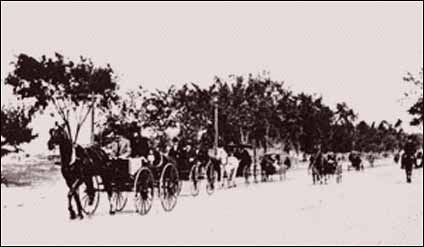
Eastern Parkway, 1897
Eastern and Ocean Parkways in Brooklyn, designed by Olmsted and Vaux, were the first parkways in the country when they were built in the 1870s. Both parkways are designated New York City Scenic Landmarks.
(Collection of the Brooklyn Historical Society)
